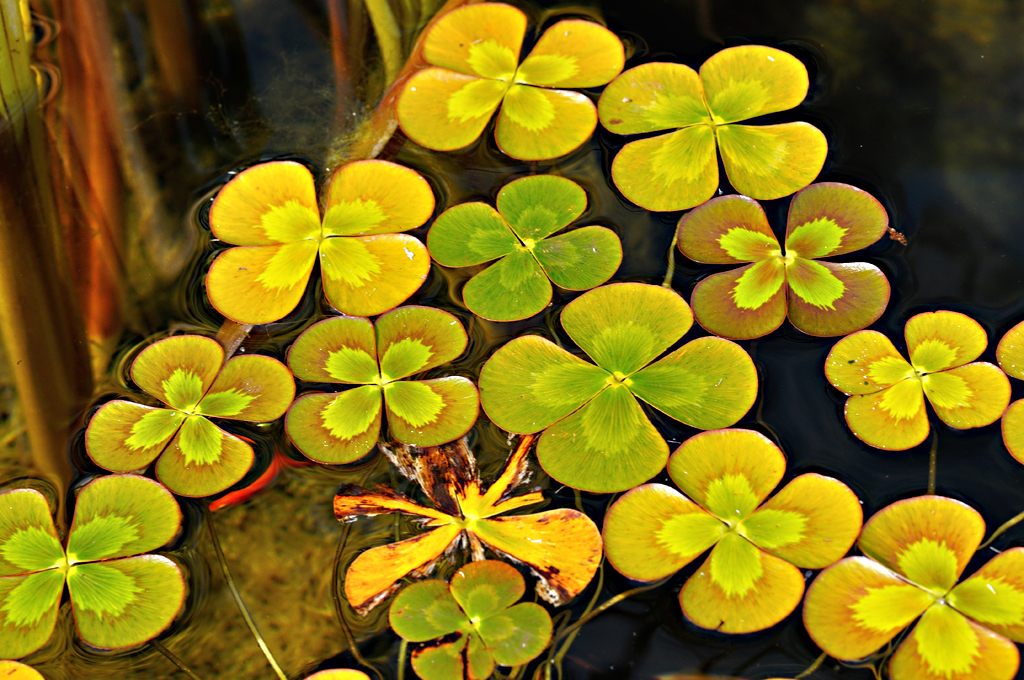Marsileaceae
|
Marsileaceae |
|
|
Plants aquatic or amphibious, rhizomatous. Stems growing on soil surface or subterranean, main stem long-creeping and giving rise to long or short shoots only at nodes; hairs laterally attached, multicellular. Roots arising at nodes and also along internodes. Leaves distichous, long-petioled, sometimes filiform and lacking expanded blades. Sori within hard bean- or pea-shaped bodies (sporocarps) arising on short stalks from near or at base of petioles. Sporangia of 2 kinds, borne within the same sorus and sporocarp; megasporangia containing a single megaspore; microsporangia containing 20--64 microspores. Gametophytes remaining within spores; microgametophytes of only a few cells; megagametophytes protruding from spores, each bearing 1 simple archegonium. Spore germination in the family occurs after rupture of the sporocarp wall allows the sporocarp contents to be hydrated. A gelatinous structure emerges from the sporocarp, breaking it into valves and carrying the sori into the water. Spore germination (gametophyte growth) and fertilization occur immediately. Regnellidium diphyllum Lindman was introduced into a wildlife pond in Mahoning County, Ohio, in 1985 and continues to persist (C. F. Chuey, in litt. 1991). Regnellidium is similar to Marsilea but differs from it in having two leaflets instead of four.
PLANT: Perennial aquatic herbs, usually floating-leaved, sometimes stranded on mud, heterosporous. ROOTS: adventitious, mostly appearing fascicled from the stem nodes, usually pinnately branched. RHIZOMES: stoloniform, usually with several to numerous branches, long-creeping (shorter in terrestrial forms), terete, glabrous or with short appressed medially-attached hairs (in terrestrial forms). LEAVES: alternate, 2-ranked, long-petiolate (this varying with water depth). BLADES: palmately 4-foliate in ours, the leaflets wedge-shaped, lacking a costa, the venation forming numerous elongate simple areoles. SORI: borne in sporocarps, these produced from the petiole base or the proximal portion of the petiole, solitary or in small loose clusters, the peduncles shorter than the petioles. SPOROCARPS: of 1 type, oblong-oval to quadrangular or nearly circular in outline, mostly flattened, densely pilose with loose shaggy hairs when young, glabrescent with age, hardwalled, dehiscing along the rim, containing numerous sori of megasporangia and microsporangia, these attached to a hygroscopic gelatinous ring (sorophore). INDUSIA: sac-like, membranous, ephemeral when hydrated. SPORANGIA: membranous-walled, lacking an annulus, ephemeral once hydrated. MEGASPORES: 1 per megasporangium, ovoid to globose, with a small hemispheric apical papilla, the surface smooth to faintly granulate, pale yellow to yellow. MICROSPORES: 20-64 per microsporangium, trilete, globose, thin-walled, pale yellow. GAMETOPHYTES: reduced, developing mostly inside the spores, the archegonia and antheridia protruding from the spore wall. NOTES: 3 genera, ca. 55 spp., nearly worldwide. The small genus, Pilularia A. Braun (6 species), is unique in the family in its subterranean nearly globose sporocarps and bladeless leaves (most easily recognized by their circinate vernation). The single North American species, P. americana A. Braun (American pillwort) is an inconspicuous plant easily overlooked by collectors. Its known distribution in the United States is widespread but quite sporadic, in part due to under collection, but also because of disjunct dispersal by migratory waterfowl. This species has been reported from southeastern California and should be searched for in Arizona. It is usually found among the emergent graminoid vegetation along the margins of ponds, ephemeral pools, and other bodies of still water. REFERENCES: Windham, M. D. and G. Yatskievych. 2009. Vascular Plants of Arizona: Marsileaceae. CANOTIA 5 (1): 30-33. |
|
